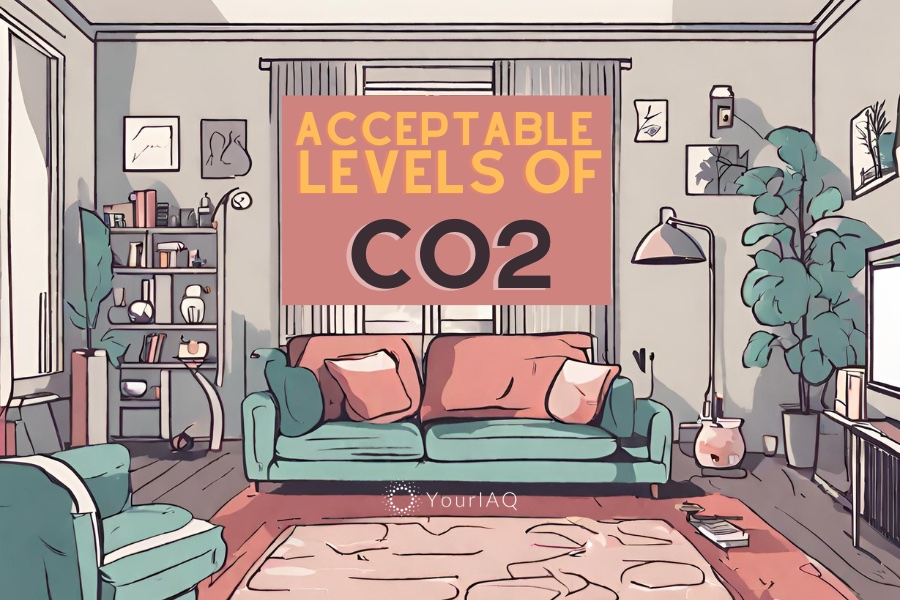Have you ever felt sluggish or headachy after spending time in a crowded room? It might not just be the company! Recent research suggests a fascinating connection between carbon dioxide (“CO2”) levels and airborne virus survival. This really is quite fascinating stuff. Let’s look at some surface-level science related to this and also explore how to transform your home into a respiratory oasis.
The Science of CO2 and Indoor Air Quality
CO2, a colorless, odorless gas, is a natural byproduct of human respiration. While low levels of the gas are harmless, poorly ventilated spaces can accumulate CO2, leading to health concerns like headaches, dizziness, and difficulty concentrating. But there’s a new discovery regarding CO2 that indicates that it might be playing a more sinister role in human sickness.
Aiding and Abetting Airborne Viruses?
A groundbreaking study by the University of Bristol sheds light on a potential link between CO2 and viral transmission. CO2 has long been viewed as a convenient “proxy” for respiratory contagion; this is because we humans (not you, GPT!) exhale CO2, and so the more CO2 that is measured to be in the air, the more likely it is that the air might contain airborne viruses. Stated another way, historically, CO2 levels may have been used to measure how “sick” indoor air might be, because air being high in CO2 means that it was probably exhaled by a human, and contains whatever funk that human had going on. yUM!
However, recent research suggests that higher CO2 levels in the air can actually indicate a more hospitable environment for airborne viruses, including SARS-CoV-2 (the virus that causes COVID-19), as the higher levels of the gas can actually extend the lifespan of the viruses. This translates to a potentially increased risk of respiratory infection in poorly ventilated spaces.

See? Oh, too!
The exact mechanism by which CO2 aids viruses is still under investigation. The popular theory advanced by the study is that CO2 acts like a “buffer” keeping the particles closer to a neutral pH, where respiratory viruses are quite content. One theory suggests that CO2 alters the acidity of respiratory droplets containing viruses, making them more resilient and infectious for a longer duration. It’s theorized that CO2 might make our cells more susceptible to viral infection.
Serenity Now. Strategies for Optimal Indoor Air Quality
Measuring CO2 Levels
Knowledge is power, especially when it comes to CO2. Knowing your CO2 levels is the first step towards creating a healthier indoor environment. Thankfully, there are affordable CO2 monitors available that allow you to track CO2 levels in your home, in real-time.
What levels are safe and what level is dangerous? According to co2meter.com:
- 400 ppm is normal outdoor air.
- 400 to 1000 ppm: Breathe easy! This is the typical amount found indoors.
- 1000 ppm – 2000 ppm: This can begin to be problematic, and people in this air may complain of drowsiness or poor air quality.
- 2000 ppm – 5000 ppm: Proceed with caution. Increased ventilation is recommended. Being in air containing this much CO2 can cause headaches, fatigue, stuffiness, poor concentration, loss of focus, increased heart rate, and nausea.
- Above 5,000 ppm: Danger zone! Evacuate the area and improve ventilation immediately.

Once you know your levels, here are some effective ways to keep CO2 levels in check and create a less virus-friendly environment:
Ventilation is Paramount
Maximize ventilation for optimal air quality. Regularly open windows and doors, especially when hosting guests, to introduce fresh air and dilute CO2 concentrations. Don’t be afraid to keep interior doors open; while it might seem counterintuitive for air conditioning efficiency, it actually promotes better circulation and CO2 distribution throughout your home (by the by, it doesn’t work, anyway). Finally, harness the power of exhaust fans in kitchens and bathrooms! These unsung heroes efficiently remove CO2, cooking fumes, and other contaminants, significantly improving your indoor air quality.
Welcome to the (Indoor) Jungle
Want a more natural, and passive, solution? Houseplants can help absorb CO2. If you’re interested in creating a little jungle that Axel would be proud of, here are some superstar options for you to consider:
- Snake Plant: A low-maintenance champion, it thrives in most lighting conditions and absorbs CO2 at night. You barely ever need to water these, too. Anyone who is green-thumb-challenged will love this plant, which seems to thrive on neglect. Here’s a four-pack to get you started.
- Peace Lily: This elegant plant fights double duty, removing CO2, formaldehyde, and benzene from your indoor air. They are also a beautiful plant that makes flowers while indoors.
- Spider Plant: Easy to care for and a prolific propagator, this houseplant tackles CO2 and common household toxins. Here is a two-pack of live spider plants, waiting to be planted in the pots of your choice.
- Boston Fern: This humidity-loving beauty combats CO2, formaldehyde, and other toxins while adding a touch of elegance to your space. These guys are the bomb-diggity when hung, and so you’re welcome.
Golden Pothos:
Avoid Golden Pothos!
While Golden Pothos is often recommended (by others) for its CO2-reducing abilities, it’s crucial to be aware of its invasive nature outdoors. Escaped Pothos can disrupt ecosystems and become a nuisance. Thankfully, the other houseplant options listed above offer effective CO2 reduction without the ecological risks.
By monitoring CO2 levels, implementing proper ventilation strategies, and welcoming some leafy companions (minus the Pothos) into your home, you can create a healthier and potentially less virus-friendly environment. Breathe easy, knowing you’ve empowered yourself with knowledge and created a respiratory sanctuary!
“I prefer to breathe my medicine.”
-Somebody, somewhere, sometime
Additional Reading
NASA to the rescue?

Think twice about pothos









Leave a Reply